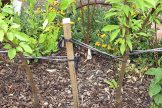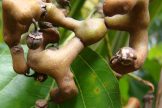
Mandarins are attractive, evergreen, compact trees. They have small glossy green leaves which contrast beautifully with the intense orange fruit. They are self-fertile and fruit easily when given full sun, fertiliser and a well drained soil that is kept moist over the fruiting period. Thinning of flowers encourages larger fruit to form. Mandarins are commonly used for screening, hedging, espalier or specimen plantings. Dwarf varieties are also available for growing in large pots. Eat fresh or use in desserts.
We took the above picture at the wonderful Rhubarb Rhubarb Organic Grocery (Preston Market).
 Important note about plant availability. Important note about plant availability.There are hundreds of factsheets on our website provided for your information. Not all plants will be available at all times throughout the year. To confirm availability please call (03) 8850 3030 and ask for the nursery. |
Varieties
Clementine – An old variety which benefits from cross-pollination with Valencia oranges as it increases fruit production. Pruning to thin the crop and let more light in will also reduce dieback. Fruit can be left on the tree without deterioration. Clementine produces a small, red-orange fruit with an excellent, aromatic flavour. It can become seedy if seedy citrus are grown nearby. The fruit ripens mid-winter.
Emperor – A vigorous and cold resistant variety of mandarin that reaches approx. 5m tall by 4m wide. The fruit ripens during May and August and must be harvested quickly. Emperor can tend to overcrop, so it’s best to thin out fruit to increase the size of what you keep. Fruit has a large, puffy skin that forms completely separate from the flesh, making this mandarin the easiest of all to peel. Flavour is good with only a few seeds. Fruit ripens mid winter, after the Imperial. NOTE: To harvest mandarins over a longer period, plant both an Imperial and Emperor.
Imperial – Australia’s most popular commercially grown mandarin, it is also ideal for the backyard. It produces excellent quality fruit. The fruit is medium to large in size, easy to peel, juicy and has a great strong flavour with a few seeds. Fruit ripens late autumn, into early winter. A strong growing tree, with an upright growth habit. If you only have room for one mandarin, this is the one to plant.
Robbie Engall Seedless – This is a superior form of Satsuma mandarin, selected by the late Robbie Engall. It is a fantastic mandarin for the kids, with large fruit, puffy skin that makes it easy to peel. It has a mild flavour and no seeds. Fruit ripens early, in April and May on a small growing tree, making it ideal for the courtyard garden or in a pot.
Ellendale – This one is an old fashioned variety. Fruit is flat in shape and has a strong, rich flavour with a few seeds. The tree is a medium size when fully grown and has a more horizontal branching shape, making it look similar to an orange tree. Skin is tighter than other mandarins which can make it a challenge to peel. Will ripen in July to August.
Thorny Mandarin – This variety produces small fruit with a very sweet flavour, ripening in mid-winter. Easy to peel skin with seeds. Unfortunately the Thorny mandarin tends to crop bi-annually, cropping very heavily one year and bearing little to no fruit the following year. Although this is a drawback, if you have the room it is worthwhile planting a Thorny as it is the sweetest of all mandarins. Depending on rootstocks, this one can be thorny or thornless. Trifoliata tend to produce the latter.
Honey Murcott – Although named a mandarin, this variety of unknown parentage is more like a mandarin crossed with an orange. The large fruit is flat in shape, with a tight skin and a tendency to be seedy. It has a distinct flavour unlike that of other mandarins, sweet but unique. The fruit ripens late, August into September, making it an ideal addition to the home orchard to increase the harvesting time of mandarins. Strong growing, upright tree.
Japanese Seedless – The tree will grow up to 5m x 4m. The fruit matures from March to April and is large, sweet and juicy. The thin skin is also easily peeled.





